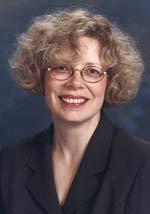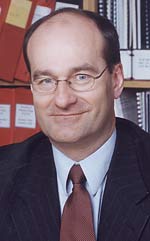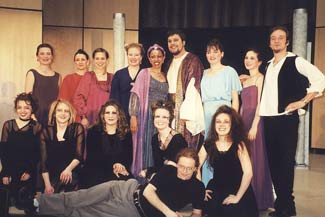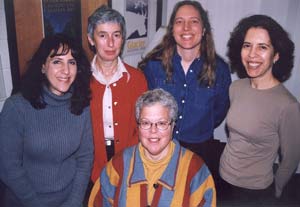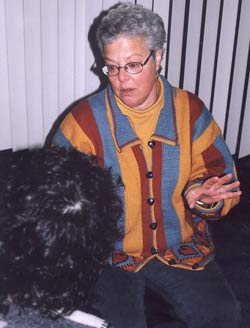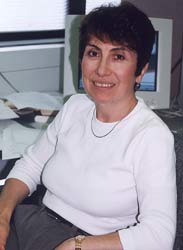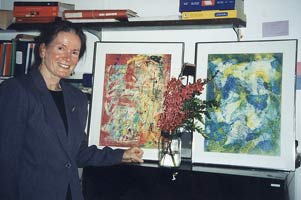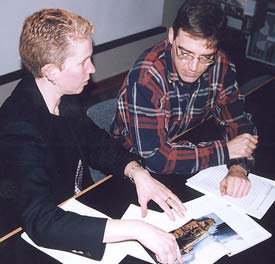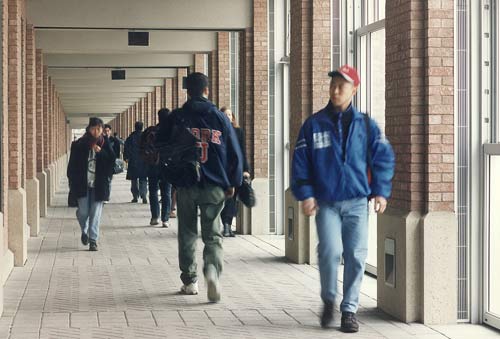|
|||||||||||||||||||||||||||||
|
|
|||||||||||||||||||||||||||||
| | |
| | VOLUME 32, NUMBER 16 | WEDNESDAY, APRIL 17, 2002 | ISSN 1199-5246 | |
| | ||||
|
 |
Leo Panitch awarded Canada Research Chair in Comparative Political Economy By Carol Bishop and Susan Bigelow 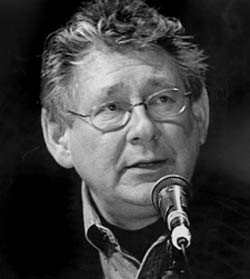
Leo Panitch York Distinguished Research Professor Leo Panitch, a renowned political economist, Marxist theorist, and editor of the Socialist Register, has been awarded a Canada Research Chair for his study of the role of the United States in leading and managing globalization. Panitch has been examining the role the US has occupied since the end of the 20th century in creating and managing a new capitalist world order, looking at the rise of finance as the leading authority in global capitalism, and the interdependency of global financial markets with the US Treasury and Federal Reserve. As Canada Research Chair in Comparative Political Economy he will assess the extent to which the traditional distinction between the productive and financial sectors of capital remains valid in capitalist theory. He will look at the auto sector as a case study, and as a paradigm of the global restructuring of manufacturing. "Canada and Canadians have long been familiar with a type of American imperialism and transformed state sovereignty that is now becoming generalized around the world with globalization," says Panitch. Quoting the Canadian historian Harold Innis, he notes that American imperialism has been made plausible and attractive in Canada and internalized in the Canadian state and society, taking a very different form from the political subordination of colonialism. Panitch is tracing how the US arrived at a strategy for dealing with the economic crisis of the 1970s, then re-established the vitality of American capital, asserting its international dominance by encouraging the economic restructuring of other states and coordinating the management of global capitalism. He will focus on how finance achieved the authority to be the leading element in global capitalism through its role in increasing liquidity, reallocating capital, and disciplining not only labour and manufacturing capital, but also the behaviour of nation states, including the US. He will investigate how this role has relied on the powerful position of the US in the new global "financial architecture". Looking at the strategic role of the US Treasury and Federal Reserve, he will examine how these two agencies have come to depend on the working of global financial markets for discipline and coordination, while the markets have become dependent on the agencies to manage global financial instability and guarantee the legitimacy of private money. He will look at the role of these agencies in international financial institutions like the World Bank, the International Monetary Fund and the Group of Seven, and their relations with ministries of finance and central banks in Europe, Canada, Japan and other countries. This will involve studying the strategic coherence that emerged out of the economic crises of the 1970s and 1980s and subsequent patterns of economic policy coordination. He will try to determine how far the leading role of the US Treasury in managing the 1994 Mexican peso crisis laid the basis for the broader role the Treasury adopted in the management of the 1998 Asian financial crisis, and Japan's acceptance of a backseat role in its own region and its subsequent initiative to found an Asian IMF. He will also examine the implications of the emergence of the European Central Bank for reproducing or altering former modes of coordination. While much of the literature today on globalization views the microchip revolution as driving global capitalism, Panitch proposes that the new information technology has facilitated, but not caused the changes in global finance, and is part of the broader political and economic restructuring taking place. A second focus of his research will be an examination of the North American auto industry and its relation to finance and the state, looking at the extent to which new technology helped lay the material base for a revitalized American economy at the heart of the new global order. "The auto industry stands out not only because of its importance to the economies of the core developed countries, but because it has been paradigmatic of the global restructuring of manufacturing," says Panitch. He will look at the mutual penetration of this industry across borders: whether it is becoming truly internationalized or just consolidating into regional blocks; whether a takeover like that by Daimler of Chrysler reflects a challenge to American hegemony or rather reflects German capital's interest in having, not only access to the US market, but access to US methods of production and direct access to the US state. This case study will allow him to assess the extent to which the traditional distinction between the productive and financial sectors of capital remains valid in capitalist theory. Panitch's research will help clarify the evolution and functioning of today's global capitalism, informed by the Canadian experience of US dominance. He will work with co-investigator Sam Gindin to understand the evolving relationship between finance, production and empire. Gindin is Packer Visiting Professor in Social Justice at York and former research director of the Canadian Auto Workers union. Panitch's project will also contribute a theoretical innovation, since the Marxist "historical materialist" approach on which his analysis is based must be revised for his study to be realized. He says new research on globalization must reach beyond classical theories of imperialism generated in the era before the First World War. Susan Bigelow is the media coordinator, faculties and research, with York's Department of Media Relations.
| |||
|
 |
From the archives By Sean Smith Av Isaacs in the archives When The Globe and Mail reported in May 2001 that the Isaacs-Inuit Gallery would be closing at that end of that month, Av Isaacs was quick to state that after working as an art dealer for 50 years, he had plans to spend at least six months at York University Archives trying to figure out "who the hell Av Isaacs was." Well, it has been well over eight months since the closing of the gallery and there have been very few sightings in the archives of the long time dealer for artists such as Michael Snow, Graham Coughtry and Joyce Wieland. Isaacs, though, has an explanation for that. "Well, I don't think I have time for retirement,' states Isaacs definitively. "I never intended to retire. There's too many projects I have. The only luxury I have is, in the morning, I can sit and read The Globe and Mail until 10:30 if I want to. It's a great luxury coming out of working everyday. "The odd time I go to a movie in the afternoon which I still feel guilty about," he muses. "At three o'clock in the afternoon, every respectful person is at work. What am I doing in a movie house?" Isaacs explains that the main project that he has in mind when thinking about his archives is to ensure that his legacy and, more importantly, his memory is complete and intact. "A lot of things remind me of things that happened," comments Isaacs on the pneumonic quality of his papers. "I intend to come back with a tape recorder and record all these things that aren't written down but which I am reminded of. This is one of the problems: the discipline of the unemployed. I find I am not using my time properly and now I am realizing it. I have too much time on my hands." Isaacs fully intends to be an active participant in the writing of a biography of his life and, more importantly, a story about the times to which he contributed. He is quick to point out that while he will probably be one of the principal characters in his biography, he will not be the only one. "It's going to be a biography with the emphasis on the environment around me. I want it to touch on Toronto, the evolution of Toronto, what was going on in Toronto and an overview of the visual arts scene in Toronto. It was a complex scene because the arts scene literally exploded in the sixties with some major forces that led to it?" He lists them, "The political forces. The economic forces. I was just swept along with it all, along with a whole lot of other people." Isaacs should have a fair bit to say about the arts scene in Toronto and the rest of the country over the last 50 years having fostered the commercial development of many of the city's better known artists during that time. Now that he is retired, though, he is content to step back and watch it develop as an observer rather than an active agent. "You can't be involved in the arts, or any kind of business really, unless you are gung-ho about it. The evolution today is so rapid and consuming that if you don't stay on top of it, you'll be left behind. "It's moving so fast now. I just realized the other day that I can't handle all of it," he adds. "It's an astonishing experience just walking around [the city] looking at visual stimulation. Rejecting some. Accepting others. Puzzling over most of it. It's wonderful." Having seen as much of it as he has during his career, one would figure that he would have a pretty good handle on the definition of "good" art. Isaacs, though, is not so sure. "I certainly have opinions of things I like and don't like. I also know though that when you come across an artist whose work you are not familiar with, it's possible you will reject it because he's ahead of your thinking and you don't know where he's going. Sooner or later you realize that unless you stay in there and work constantly at it, your ability to properly assess an artist is fading. "You still know what you like and what you don't like but that has nothing to do with what is happening in art. Things are in vogue and then they pass. I use this argument again and again. Greco was out of vogue for a hundred years or more and then he was rediscovered at the turn of the century. I don't think there's any final answer. My artists might be hot shots today, forgotten 20 years from now and rediscovered 50 years from now. Nothing's permanent." Isaacs reflects that, "Certain artists or certain periods can be seen sympathetically at certain times or can affect certain times. You know. They appear and they reappear again. Very few artists have eternal values...and all that crap." Sean Smith is archivist's assistant with York University's Archives and Special Collections.
| |||
|
|
Symposium marks the creation of York's Hellenic Heritage Chair in Modern Greece By Susan Bigelow 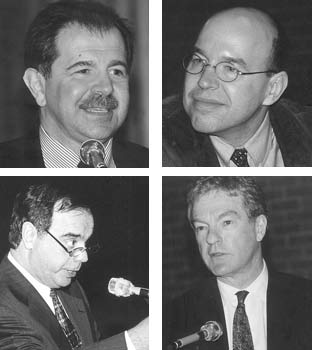
From left, clockwise: The Honourable Alexis Alexandris; Thomas Gallant, University of Florida historian; David Hutton, Canada's ambassador to Greece; and John Dagonas, Chair of the Hellenic Heritage Foundation To mark the creation of York's Hellenic Heritage Chair in Modern Greece, the Department of History held a two-day symposium in late March. "Modern Greece in an International Context: A Symposium", traced the modern history of the descendants of Europe's classical forebears, including the Greek diaspora, at a time of great change on the European continent. Guests included Consul-General of Greece in Toronto the Hon. Alexis Alexandris, who is also a Greek historian; Canada's Ambassador to Greece David Hutton; Oxford University historian Richard Clogg; Panagiotis Tsakonas, historian with the University of the Aegean and senior advisor to the Greek foreign minister; and Thomas Gallant, University of Florida historian and author of the non-fiction bestseller Modern Greece. "We are honoured that the Toronto Greek community has chosen York as the site of this Chair, and proud to have assembled such a distinguished group of historians," said Marlene Shore, Chair of York's History Department. The Hellenic Heritage Chair in Modern Greece will be fully endowed this year at $2 million by the Hellenic Heritage Foundation of Toronto, with a $500,000 contribution from York. The new program will enable students, including more than 1,000 students of Greek heritage enrolling each year at York, to study Greek history, language and culture. "The establishment of this Chair has long been a dream of the Greek community and we feel a great sense of pride and accomplishment to have turned that dream into reality," said John Dagonas, Chair of the Hellenic Heritage Foundation. "We hope it serves as an inspiration to the next generation." Susan Bigelow is media coordinator, faculties and research, with York's Media Relations Department
| |||
|
|
New VPs joining the York community By Michael Todd President and Vice-Chancellor Lorna R. Marsden announced the appointment of Bonnie Neuman as York's next vice-president students and alumni and Gary Brewer as vice-president finance & administration.
Bonnie Neuman "Neuman is exactly the right person to take on this portfolio at this time," says Marsden. "She has energy, enthusiasm and a knowledge of the Ontario system along with a wide ranging perspective on the key issues. I am delighted to welcome her to our team.""I'm also delighted to be joining the York University community," says Neuman. "The quality of the academic programs at York and the energy and involvement of York students in campus issues are real attractors. I'm looking forward to the challenge of helping York to not only maintain, but also add to excellent student services... and this will indeed be a big challenge, as student numbers grow dramatically with Ontario's double cohort in 2003. "I'm very interested in creating new opportunities (and enticements) for York students to engage in campus life. Engagement is great for students in a number of ways, starting by simply meeting new people and making friends, and following through with benefits such as learning extra career skills, mentoring with successful York alumni, knowing people from other backgrounds and cultures, defining and refining your particular destiny. A key goal is for students to genuinely enjoy and identify with some part of their own particular associations and experiences of York - that has to happen in order for students to 'experience the small' while also benefitting from all the advantages of a big university. The four to five years spent on campus getting a degree is the starting point of a lifelong membership in the York community, so I want to make sure York students are 'happy alumni' from their first day on campus!" Neuman succeeds Professor Deborah Hobson, who steps down at the end of June. She brings enormous strengths and experience to this important portfolio, having earned her bachelor and master's degrees in English literature and a doctoral degree in educational administration from the University of Alberta. She has served in a number of senior student service roles at the University of Alberta, and is currently associate vice-president student services at Brock University where she has worked since 1998. The vice-presidency students and alumni at York University is a senior position dealing with all matters relating to the lives of students outside the classroom as well as York's growing alumni population. The position has operational responsibility for the Office of Admissions, the Registrar's Office, Student Financial Services, Student Affairs, Sport and Recreation, Alumni Affairs, and the Faculty-affiliated colleges. The position requires strategic planning, a love of students and a willingness to help solve their problems. The responsibilities of provost (i.e. student discipline) fall into this portfolio. Neuman's term as VP begins July, but she will be on campus beginning June 1. Gary Brewer's appointment as vice-president finance & administration follows the resignation of Phyllis Clark, who has accepted a position as vice-president finance & administration at the University of Alberta. Brewer currently serves as chief financial officer and assistant vice-president finance reporting to Phyllis Clark. He came to York University in 1995 as the director of budgets & planning, after serving in a number of successively more responsible financial positions at Ontario Hydro. He was appointed to his current position at York in 1997.
Gary Brewer "I've greatly enjoyed my time at York," says Brewer. "That's a large part of why I'm looking forward to the new challenges at hand. It's been a challenge the last few years to accommodate the budget cuts by government and at the same time develop plans to respond to that which still maintain the academic side of the University." Brewer notes there are always new and compelling budget issues that arise. "There's rising energy costs and the pressures of the double cohort to name a few that have come or are coming our way," he says. But most of all Brewer says he's enjoyed the breadth and depth of issues and the people he's worked with. "And helping on the academic side," he says. "I don't often get a chance to get directly involved in academic projects but when I have the chance to help with special projects it's a wonderful thing. I was involved in the establishment of the Joint Design Program with Sheridan College a few years ago, and more recently with the negotiations associated with our Collaborative Nursing Program. During his years at York University he has reorganized and rebuilt the finance area into a very strong team, and has worked across a variety of areas of administration on special teams and assignments. He currently serves on the President's Priorities Committee and the University Administrators Forum. He supports the Finance, Property & Staff Resources, Investment, and Audit Committees of the University Board of Governors, and serves on many internal committees. The president and the Executive Committee of the University Board of Governors reviewed the portfolio, considered the options for the appointment of Clark's replacement and concluded that we had a very strong replacement in Gary Brewer who brings an exceptional understanding of and dedication to the interests of the academic mission, students, staff and the strategic directions of the University. "Gary is exactly the right appointment for this position and he will do a fabulous job for York," said outgoing VP Phyllis Clark. Brewer began his new duties April 15.
| |||
|
|
York's first full-length student opera hits high note
Back row, left to right: Tamara Meisenheimer, Sarah Graydon, Stefanie True, Jennifer Carter, Melissa Davis (Dido), Curtis Clarke (Aeneas), Tammy Everett, Lucia Mancuso, Rick Roos.
[enter Dido, Belinda and train]
BELINDA
CHORUS
DIDO
BELINDA
DIDO
BELINDA
* * *
With those words begins Henry Purcell's 313-year-old opera Dido and Aeneas. While Purcell's work has been around for hundreds of years, this is the first year York's Department of Music's has ever produced a full-length opera performed by students, said Michael Coghlan, York's Music Department Chair. The performance was under the direction of renowned Canadian mezzo-soprano Catherine Robbin who is voice coach for York's opera program.
Robbin has performed with many of the leading conductors throughout the world. Her operatic appearances have included the title role in Handel's Floridante with Alan Curtis and Tafelmusik, Bradamante in Handel's Alcina for the Vancouver Opera, and Medoro Orlando with Christopher Hogwood and the Academy of Ancient Music, among others.
The plot of Purcell's opera concerns Dido, queen of Carthage, who marries the Trojan prince, Aeneas, who is madly in love with her. While Dido and Aeneas are out hunting, an evil Sorceress and her assistants plot the destruction of Dido and Carthage. Soon, an evil witch disguised as the God Mercury stops Aeneas. She tells him that he must abandon Carthage and found a new Troy on Latin soil. While Aeneas hates the thought of leaving Dido, he cannot refuse a god's command. In the end, Aeneas decides to defy the god's command and stay with Dido. However, Dido refuses to stay with a lover who even considered leaving her and kills herself.
Purcell wrote only one full opera, a short work supposedly designed for a girls' school, the tragic story of Dido and Aeneas. Dido's final lament, before she kills herself, follows the model for such compositions established by Monteverdi 80 years before.
Coghlan, who described Purcell's work as "wonderful...and it's less than an hour!" was right on both counts. York students - comprising chorus, main performers and orchestra - put in a moving performance of this tragic tale inspired by Virgil's Aeneid, a Latin epic chronicling the destruction of Troy and the founding of Rome under the artistic direction of Robbin, who is also a professor at York.
The March 13 performance featured the strong vocal talents of Melissa Davis as Dido and Tammy Everett as Belinda. Even battling the flu Davis' voice was impressively rich. Curtis Clarke played Aeneas and Michael Sawarna was the Sorceress/Sailor. Prancing/ giggling witches included: Erica Charis, Kirsten Dyck, Joanna Christopoulos, Keira Grant, Diana Di Mauro and Sarah Grosjean. The leads were competently accompanied by student orchestra and chorus. The wonderfully smooth technical direction was by Aaron Armstrong.
Henry Purcell (1659-1695) was one of the great English composers, flourishing in the period that followed the Restoration of the monarchy after the Puritan Commonwealth period. He spent much of his short life in the service of the Chapel Royal as a composer, organist and singer. With considerable gifts as a composer, he wrote extensively for the stage, particularly in a hybrid musico-dramatic form of the time, for the church and for popular entertainment. Purcell is considered a master of English word-setting and of contemporary compositional techniques for instruments and voices. He died in 1695, a year after composing funeral music for Queen Mary.
Other stage works by Purcell are in the hybrid form now known as semi-opera, combining spoken drama and a musical element that in the concert-hall may be performed apart from its wider dramatic context. These semi-operas include King Arthur, with a text by the poet John Dryden, a work that includes intriguing music for a chorus of "cold people", frozen by the "Cold Genius" but thawed by the power of Love.
* * *
DIDO
CHORUS
| |||
|
|
Going on a bender: York staff and faculty lineup for Retirement Centre's yoga class
Take a deep breath. Feel better? Chances are you will if you take the yoga "stress-buster" class led by Karen Gray, director of York's Retirement Planning Centre.
Gray who first got interested in yoga about eight years ago has been running her yoga class for the last couple of years as an antidote to workplace stress. And you don't have to be buff or a Cirque de soleil contortionist to partake either.
"As people grow older they don't want to be doing things like aerobics," says Gray. "Yoga, like walking, is always something you can do - even in retirement. For instance, I teach a class of seniors outside York and I see the changes - physically and emotionally - that yoga brings them."
Gray says participants take it at their own pace. "The focus is on some stretching and breathing exercises."
Yoga is thousands of years old, says Gray, and takes many forms. "But essentially it's about strength, endurance, balance, stretching and getting to a quiet place."
Gray is particularly enthusiastic about her workplace yoga program. "I think it's a great thing for staff. It's a way to reduce stress and settle back into yourself. Experiencing calm makes you more productive.
"My program focuses particularly on shoulders and wrists, postures and eye exercises. These are computer related points of stress for our bodies. So we're looking both at physical and psychological stress in our yoga program."
Gray is now pursuing her own instructor accreditation involving a teacher training program, 500 hours of instruction, volunteer work and written assignments. "I started taking private lessons a few years ago and then found yoga really became a passion for me. And I love working with older people. Yoga is a way to do that," says Gray.
"I'm doing it partly for myself, for flexibility and as a way to help with osteoporosis. But beyond that yoga has allowed me to explore myself at a developmental level. It's an awakening and coming more into yourself.
"I suppose that all sounds very New Age but it's really the only way to describe it. I've never had a passion like this before. And the great thing about it is, it's something you can do forever."
Gray's yoga stress-buster courses will be offered April 23, 30, and May 7 from noon to 1pm, then repeated from 1 to 2pm.
| |||
|
|
The inside story: How the Visible Human Project has changed the face of anatomy
It used to be Adam and Eve could only be found in the Bible, now their corpses are on the Web, frozen, sliced thinner than prosciutto, scanned, and put back together again digitally into 3-D virtual life as part of the Visible Human Project (VHP). "Adam" in this case is a US ex-con executed by lethal injection for killing a house owner while trying to steal a microwave. "Eve" died of natural causes. Both willed their bodies to medical science.
At a recent Brownbag luncheon Professor Naomi Adelson (York Centre for Health Studies and Anthropology/Arts) gave a talk on how Adam and Eve may reconfigure how we think of and view the human body. In "...[T]o Draw the Dotted Outline of the Future Autopsy: Contemplating 'Adam' as the Next Anatomical Frontier", Adelson says we have suddenly moved from "flesh to data". The human body is no longer a cadaver for medical students, it is a 3-D model assembled from MRT and CT scans of frozen cross-sections of the human body.
If you visit the VHP Web site you can buy posters, books, CD ROMS, indeed almost everything you would need if you were a medical student or a medical school and would rather not get your hands dirty handling real cadavers.
The question Adelson raised is what are we to make of what she calls the "commodification" of the body? "The body has become a 'data set'. It's indicative of the ways in which we socialize our bodies and medicalize our world. We have reached the frontier between human and machine. Most medical schools still use cadavers, but for one school - Montreal - who used computer simulations for one year, rather than cadavers, professors and students noted what they said was a 'loss of dimensionality'. It was a concern. It wasn't like the real thing."
Adelson noted that at the end of the year a memorial service is held for the cadavers in medical schools. "It's a way of saying these were human beings that are worth caring about. You don't get that with data sets."
Adelson said Renaissance artists were among the first to study and show in detail the workings of the human body but "dissection was a conscious placing of man and his body in the universe. It wasn't just dissection. Whereas the 'medicalized' body is seen as removed from humanity. Hence the metaphor of the machine."
Perhaps we should be conscious of practices that define the "truth" of the body, said Adelson. "Is the VHP about seeing but not feeling? The cadaver is linked more closely to being human in all its grotesqueness and messiness, whereas the virtual body has no touch or smell...it is machine as man."
| |||
|
|
Fighting the stigma of psychiatric disability
Access York's stigma sub-committee includes, seated, Enid Weiner, Psychiatric Dis/Abilities Program (PDP) coordinator; and standing from left, Karen Swartz, Office for Persons with Disabilities coordinator; Gill Teiman, special assistant to the president on equity; Jennifer Lund, PDP coordinator's assistant; and Debra Glass, director of Student Affairs. Absent is Marg Gilligan, disability management coordinator, Human Resources.
It's hard enough to manage exam stress, but for students with psychiatric disabilities the mounting end-of-year pressure to finish essays and prepare for finals can increase symptoms of the illness and spell academic disaster. Fearful of disclosing, they may drop courses and have to start over, losing time and paying double to get a university education.
Not if Enid Weiner can help it. She is coordinator of York's Psychiatric Dis/abilities Program (PDP). For 12 years, she and her assistants like Jennifer Lund have been steering students with clinical depression, obsessive/compulsive disorder, bipolar disorders and schizophrenia towards academic success.
York is the only University in Canada that provides services for students with psychiatric disabilities distinct from services for those with physical and sensory disabilities and learning disabilities. It is known for its work in the disability field. In 1999, it became the first University to receive the Canadian Foundation for Physically Disabled Persons corporate award for its commitment to accommodating the needs of students, staff and faculty with disabilities.
"I think the issues, while common with other students with disabilities, are also quite different for students with psychiatric disabilities because their disability is episodic," said Weiner. "Students can do extremely well and produce 'A' work one month and the next month their grades, class participation and academic performance can plummet."
Weiner provides educational support to about 170 students, but there is no way of knowing how many undergraduates with psychiatric disabilities there are at York. Many aren't aware of the services or have concomitant learning disabilities and are already receiving services through the Learning Disabilities Program. But many don't think of themselves as having a disability or, if they do, are reluctant to identify themselves. "Of all the disability groups, I think they are the most stigmatized."
Whacko, crazy, demented, mad, loony, nuts. Even if a person never hears anyone calling her these demeaning names, she fears the stigma. Many students never disclose their psychiatric disabilities until they are about to lose a course or their year, because they dread a professor's reaction.
Weiner decided this had to change a couple of years ago after hearing comments made by students who felt misunderstood and insulted because of attitudes toward their psychiatric disabilities. Access York created a sub-committee to educate faculty, staff and students about the stigma of psychiatric disability.
"We decided there was so much misunderstanding about people who have a mental illness," said Weiner. "There was so much negative stereotyping, that it was really important to have a sub-committee to fight the stigma faced by students and staff."
Access York advises University policy makers on the needs of persons with disabilities who work or study here. Until the stigma sub-committee was created, Access York focused more on persons - students and staff - with physical, visual and hearing disabilities than on those with psychiatric disabilities. "Representation for their concerns was not as strong as it could have been," said Access York Chair Paul Delaney, who teaches physics and astronomy.
The stigma subcommittee is taking steps to educate the York community. (Indeed, this article is part of its awareness-raising campaign.) It has brought in speakers to talk about psychiatric disabilities to senior administrators and academic program directors. It plans to do the same for front-line staff across the University.
One of PDP's objectives is to reach those students with psychiatric disabilities who are reluctant to officially identify themselves. Disclosure can open the door to services, financial assistance and academic accommodations. "If they know what supports are available, they can enhance their chances of success," said Weiner. There are bursaries, a petitions committee to assess academic appeals, student support groups and a student-to-student mentoring program.
Many students choose not to disclose their psychiatric disabilities until they are about to lose a course or their year. Suddenly, when they need consideration at the end of the year, professors wonder why they didn't tell them earlier.
"It's more complicated than that," says Lund. "Many students with psychiatric disabilities won't disclose until it's almost too late to rescue their failing grades. They've chosen not to inform professors because they want to avoid reactions of curiosity, disbelief and fear. They want to prove they can pass like everyone else."
Such fears, frustrations and feelings surface at a monthly support group meeting led by Weiner and Lund. "It makes you feel vulnerable." "I thought I should be able to do it myself." "I feel like a failure if I have to rely on others." "It's demoralizing having to explain over and over. It sort of feels like you're taking your clothes off all the time." "People think you're fabricating illness." These are powerful disincentives to disclosing a psychiatric disability.
It takes a lot of determination and courage to go to university "especially when we know many of us will relapse and have to pick ourselves up again," said one student in the support group. Trying to balance a mental illness and education requires perseverance, and mental health must be the priority. Smaller, more manageable course loads mean "it takes us longer and costs us more" to finish a degree, said one student.
It's no easier for graduate students with psychiatric disabilities. In fact, they face a more competitive academic experience. You're wrong if you think this deters them. In a 1995 survey of graduate students, the Institute for Social Research found that 7.2 per cent of 1,800 respondents said they had a disability. Fifteen per cent - by far the largest category - identified their disability as a psychiatric illness. "I was astonished," said Gill Teiman, a stigma subcommittee member and special assistant to the president on equity.
While mental illness may be a real barrier to a university education, enrolling in university can be a strategy for recovery. Listen to students in the support group: "By being here, you're pushing the box, you're pushing your own limits." "University keeps you from being isolated.""You learn patience." "You figure out what's best for you." "You learn new skills." "The successes you have when you reach some of the little goals empower you to try again." The support group itself can be part of a strategy for success. "I look at it as an insurance policy," says one student.
"The ideal is that students become their own advocates and move from a place of fear to one of confidence," said Lund.
One student's experience Advice from one student with a psychiatric disability: "You don't have to wait for a crisis to happen to see that there are people and options that can help you." First-year university was a disaster for sociology student Sandra Smith (not her real name). Away from home, sharing a residence room at the University of Toronto's Mississauga campus with someone she didn't know, she started having panic attacks and feeling overwhelmed. She dropped out, found a job renting videos at Blockbusters and settled into her own apartment. University was out of the question until her boyfriend suggested York. York seemed more accommodating right from the start. The application explained who to contact if you had a disability. Sandra enrolled in four courses, ready to try again. All went well until the spring. Spring is always a bad time for Smith and end-of-year academic pressures overwhelmed her so much, the doctor ordered her hospitalized. She phoned Enid Weiner, coordinator of York's Psychiatric Dis/abilities Program.
Enid Weiner, Psychiatric Dis/Abilities Program (PDP) coordinator, counsels a student. "I was worried that I would lose the money I had invested, worried I would lose my courses and be broke. Enid explained all my options. She said, 'You worry about getting well and I'll help you finish.' " She dropped one course, completed two and deferred another. She signed up for a second year."Enid kept in touch. If I hadn't known there was a disability office there and that I could qualify as a disabled student to take fewer courses, I don't think I would have come back to school at all." Last year, Smith faced a similar disruption in her school year. Sociology Professor Peter Landstreet suggested an unusual alternative to taking his course. She could review the manuscript of his new text. "It was one of the best educational experiences I've ever had." She would cover the same material as students in the class and "help him out as well." He was accessible - in person and on the phone - and flexible, giving her an extension when she needed it. In the end, she presented him with a 40-page critique from a student's point of view, received acknowledgement in his book, framed his letter of thanks and admired the A+ on her transcript. "After two to three years of struggling and feeling completely incompetent, it was amazing to feel I had finished, accomplished something and that I was respected. He never made me feel bad about my disability. He never asked questions. He let me see professors in a different light as personable, friendly and open. He treated me as an equal. I didn't have to justify myself, which took so much pressure off. It was great working with him. He was so encouraging." She's offered to critique two extra chapters he's working on. This her third, year, Smith disclosed her disability to professors early in the year in a letter drawn up with help from Weiner. The letter says she has a disability and that she will let the professor know what she needs. She feels a "bit of shame in it. I don't want to have to use this letter." "We don't want to require accommodations. We want to get by as smoothly and as unnoticed as possible." But disclosing "is a bonus," she says. "I let them know I'm there. I have this insurance policy." "I feel like my life has been on pause for the last few years. Finally I'm getting back in control of things, with concrete goals for a future. I've spent a long time thinking I didn't have a future." She's aiming for social work in the justice system and maybe, eventually, teaching at a university.
A professor's extra effort Religious Studies Professor Patrick Gray had the ideal credentials to accept the challenge of a student with a psychiatric disability into his third-year course, which was already full. He is an experienced member of the clergy and grew up with a brother with disabling heart disease and another who is intellectually impaired. Still, he is a demanding teacher and was worried he didn't have proper training or knowledge to help this student. Gray decided to meet this 30-something prospective student. Medication made the student impassive, but Gray suspected there was a good mind at work. "I didn't want to offer academic charity, I didn't want to compromise him. I was really concerned that he could demonstrate that he could achieve what other students could achieve." Gray was also worried about how much extra time he could devote to this student. The class was very big. As it turned out, Gray spent about an hour each week going over tests to clarify and unravel meaning in the student's sometimes rambling answers. "I had to give him additional opportunities to get across his mastery of the material in the same way you would allow a student with a learning disability to take an extra two hours to write an exam." The meetings "took hard work on the part of this instructor." The student earned a B+ on his mid- term and a final passing grade. Gray says expanding classes and fewer resources make it harder and harder for professors to give any student individual attention. "Our job as teachers is to find and let fly that beautiful mind.... That's what you hope for everybody. ... It takes an extra special effort. And someone has to be committed enough to do it, to go the extra mile." Helping this particular student "was worth it and I'm very gratified that it was helpful to him." So is the family. According to his parents, being in Gray's class was a positive experience that brought hope and new meaning to their son's life. They report that he is doing better on his medication and his thoughts are more focused this year. Depression in the workplace Marg Gilligan believes the World Health Organization (WHO) when it identifies depression as the health problem of the 21st century. For four years, the disability management coordinator in Human Resources has been helping York University employees on short- and long-term disability. A few have physical injuries or disabling related diseases such as arthritis. Many are clinically depressed. The WHO estimates that one in four people in the world will be affected by mental health or brain disorders - depression, schizophrenia, bipolar disorder, addiction, epilepsy - during their lives, but few will seek or receive treatment. Depression is the fourth leading cause of disease in the world. It will be second by 2020, predicts the WHO. "Rare is the family that will be free from an encounter with mental disorders," writes WHO director-general Dr. Gro Harlem Brundtland in her introduction to the World Health Report 2001 on Mental Illness. Canada has the third highest rate of depression in the world. According to a study published in the scientific quarterly Chronic Diseases in Canada, depression and distress cost us at least $14.4 billion in treatment, medication, lost productivity and premature death in 1998. At York, Gilligan encourages employees who are ill to take advantage of York benefits - the Employees Assistance Program, physiotherapy, massage - so they can get their lives back on track as quickly as possible. Most employees also have access to psychological counselling through their benefits plan. "The longer they stay home, the harder it is to adjust to a return to work", says the former nurse and counsellor. Statistics show that after six months away, 50 per cent don't return to work. Staying at home is often isolating and breeds self-doubts and fears. A return to work means a return to functioning in a familiar role and the self-esteem that brings. Re-entry can be stressful for colleagues as well as the returning employee. So, recently Gilligan met with co-workers and supervisors in one unit to demystify depression and discuss how they might respond to a returning colleague. She answered questions like: How serious is depression? They look so well and seem so cheerful. Are they really depressed? How do we treat them? Do we have to be cautious and handle them with kid gloves? How can we help? "This is not your average funk," Gilligan explained. "This is a very deep hole. It's not something you can snap out of by telling yourself to smarten up and pull up your socks." Treat the returning colleague the same way you did before, said Gilligan. Don't probe into personal matters. Be clear about job expectations, be prepared to reorient them, provide written instructions and give lots of feedback, both negative and positive. If the returning employee becomes upset, ask how to help at that moment and refrain from giving personal advice. So far, her advice has worked. The returned employee has found a supportive environment, said Gilligan. Gilligan plans to offer such pre-emptory meetings whenever requested and consented to by a returning employee. And Human Resources is planning seminars and forums to create a better awareness about psychiatric disabilities, especially depression. The department also hopes to lend computers that are available to employees on long-term disability so they can maintain links to York, have access to the Internet and lessen feelings of isolation.
| |||
|
|
Senate Synopsis
At its 487th meeting held on March 21, 2002, the Senate of York University:
- by statutory motion, the dissolution of the Academic Computing Committee and the Library Committee and the establishment of the Standing Committee for Libraries and Information Technology;
- Certificates of Language Proficiency in Modern Greek, Portuguese and Spanish, Faculty of Arts;
- closure of the Canadian Studies Degree Program, Faculty of Arts;
- changes to the Bachelor of Health Studies Degree Program, Atkinson Faculty of Liberal and Professional Studies;
- changes in the requirements for the Certificate in Environmental Landscape Design Program and designation as the Professional Certificate in Environmental Landscape Design, Faculty of Environmental Studies;
- the closure of the Joint Centre for Asia Pacific Studies and the chartering, for an initial period of six years, of a York Centre for Asian Research (YCAR);
- nothing shall be included in the Senate Handbook that purports to be a statute, by-law, rule or regulation of the Senate unless that statute, by-law, rule or regulation has been adopted by express resolution of the Senate;
- no new edition of the Senate Handbook, shall be published with any amendments, revisions, alterations, or changes of any kind unless such amendments, revisions, alterations, or changes have been included in the body of a Senate Agenda, and adopted by express resolution of the Senate;
- any member of the Senate may propose an amendment, revision, alteration or change to the Senate Handbook;
- establishment of a sub-committee on Faculty Research Awards and Grants by the Faculty of Education Council;
The complete text of the minutes will be posted on the University Secretariatís Web site at
www.yorku.ca/secretariat/senate/
. For further information on any of these items, please contact the University Secretariat.
Next Senate Meeting
4pm on Thursday, April 25, 2002, in the Senate Chamber
| |||
|
|
New indicators of climate change
Marianna Shepherd
PMCs are cirrus-like, meaning that they are high-altitude clouds that generally appear in narrow bands. However, these particular clouds are appearing much higher than cirrus clouds would be expected to - in fact, they are appearing in the upper parts of the mesosphere, from 80-83 km high.
"Sightings have increased in the last few decades," Shepherd explains. "And there are no records of such clouds prior to the late 19th century. They normally occur at high latitudes in summer time, although the global extent has widened quite a bit and there are sightings even as low as 41 degrees."
Satellite data are helping scientists such as Shepherd to get a much better understanding of PMCs. This is because such clouds are sometimes difficult to observe from the ground, and may be confused with cirrus formations. Satellites can pinpoint certain regions of the mesosphere for observation, as well as collecting data during the day, which is difficult for ground-based operations. These observations show that PMCs are formed by ice crystals or ice coated dust particles.
"Basically, water is rare at such altitudes," says Shepherd. "Model predictions show water content in the upper mesosphere at 1.3 to 1.5 parts per million. Observations from satellites over the last ten years suggest that the amount of water is much more abundant than these models would predict - about 16 to 20 parts per million. This amount of water, by any accounts, is abnormal. Studies have shown that the mesopause H2O content is expected to increase in parallel with global warming due to increased CO2 and methane. This in turn increases the super-saturation in the cold summer mesopause and may increase the occurrence of PMCs."
What, then, is the significance of such data? Another indicator in the mesosphere is the presence of carbon dioxide at such high altitudes, which Shepherd believes could show an upwelling from the stratosphere and troposphere, the lower atmospheric levels.
"This becomes a signature to be studied," Shepherd says. "And this will tell us something of the condition of the atmosphere as a whole. The changes taking place may eventually lead into diagnostics on climate change. In the troposphere there are so many perturbations it is difficult to make a judgement. They may be caused by local effects, and so it is difficult to determine trends. In the mesosphere there are significantly less perturbations, and so they are more indicative of changes."
The study actually encompasses more than just the clouds, though they are the most visible part of Shepherd's research area. She is actually examining a triumvirate of issues: temperature, water vapour and PMCs, and then how these inter-relate within the context of climate change. Shepherd has had the help of two York graduate students for her study, Janti Reid and Xiaoqi Wang.
One of the issues that they are studying is the upper part of the mesosphere, the mesopause, where temperature is becoming a concern. The formation of PMCs may have something to do with decreases in the temperature at this level, down to below 150 Kelvin. This may sound like fluctuation from 'very cold' to 'really stinking cold', which it certainly is by tropospheric standards, where water freezes at 273.15 K. However, at this temperature in the mesopause an important change takes place.
"150 Kelvin is the frost-point when we can talk about icing on dust particles, should water be present," points out Shepherd. "Temperatures observed in the mesopause are often now down to 140, 130 Kelvin. The presence of CO2 can absorb heat from the atmosphere, and then with the presence of water - a product of the oxidation of methane - conditions are created for the formation of ice crystals. Some dust particles from meteors give a perfect base for these ice crystals."
The knowledge of this process gives scientists a hint as to what is going on in the mesosphere. The fact that PMCs seem to be expanding down into 55 degrees and even 40 degrees latitude - beyond the polar cap - is a trend that could hold some major clues as to how emissions of CO2 and methane are affecting the overall climate of all levels of the atmosphere.
Derek Irwin is master's student in English and writer in York University's SPARK (Students Promoting Awareness of Research Knowledge) program. The program was initiated by NSERC (The National Sciences and Engineering Research Council of Canada) in 1999, based on a model developed at the University of Guelph.
| |||
|
|
In Brief
Alumnus Steve MacLean to go sky-high
Canadian astronaut and York alumnus Steve MacLean is scheduled to blast off in April 2003 on a 10-day mission to add solar panels to the International Space Station. MacLean, a member of the York University Alumni Association Board of Directors, will be aboard the shuttle Endeavour. He first went into orbit in 1992 as a payload specialist aboard NASA's space shuttle Columbia. At York MacLean earned a BSc in honours physics in 1977 and a PhD on the laboratory simulation of interstellar dust grains (a branch of the spectroscopy of solid-state matter) in 1983. As well, he was awarded an honorary DSc from York in 1993.
Make that 'fair trade' with your coffee
The next time you savour a cup of coffee, spare a thought for where your money went when you bought it. Likely only a fraction of it went to the men, women and children who cultivated and handpicked the bean crop - probably under harsh conditions. The largest portion would have gone to the companies who roasted and shipped it. Is that fair? No, say speakers who recently held a panel discussion on the Keele campus entitled "Promoting Fair Trade at York (or How to Feel Better About Your Coffee Habit)". In the spirit of the event, the Faculty of Environmental Studies' student-run café, Counter Culture, provided complementary Fair Trade coffee from Alternative Grounds.
Darryl Reed, director of the Faculty of Arts Business and Society Program, organized the panel. Several program and outreach centres at the University sponsored the event, which represented people working on the economic, social and ecological issues surrounding the production and consumption of coffee. The discussion was hailed as the first step in a fair trade campaign at York. Participants plan to continue developing strategies for getting fair trade coffee into outlets at the University. Parallel to this initiative, the University's Las Nubes project is creating a marketing plan for fair-trade, shade-grown, organic coffee from its rainforest area in southern Costa Rica.
No debate about it!
Our debaters know what they're talking about! In March two York Debating Society teams finished in the top 10 out of 34 at the Canadian National Debating Championships. The team of Emily Cohen and Eric Brazier finished 6th overall; and Josh Deitz along with partner Omar Fairclough came in 10th place. Fairclough also snagged the 5th place individual speaker award and Eric Brazier brought home 6th place honours in the public speaking event. The event, the top debating tournament in Canada, was hosted by the University of British Columbia.
Life's a (natural) gas at on campus
The University is upgrading its campus transportation fleet to compressed natural gas-powered vehicles (NGVs) as a more environmentally-sustainable mode of transport. The switch to Ford factory-produced NGVs fueled by ENRG natural gas suppliers and Enbridge Consumers Gas will start in May. York plans to replace a fleet of 10 transportation vehicles with NGVs over the next two years, and will add a 24-seat natural gas-powered bus early this summer. The University's fleet will re-fuel at stations off campus near the university.
The move is in line with the university's efforts to encourage commuters to become "green"-minded by using more environmentally-friendly transport options, such as car-pooling and taking public transit. "York is one of the largest single-site destinations for private vehicles in the GTA, and the air pollution generated by 33,000 vehicles coming to the Keele campus each day is significant and must be reduced," said Tom Arnold, director of parking and transportation services at York. The upgrade will not only be more environmentally sound but will also generate savings of 25-50 per cent in fuel costs, and will reduce maintenance costs because engine parts stay cleaner longer.
Students take top honours in speech contest
Competing against 54 Japanese-language students from every university in Ontario and several language schools, our students shone the brightest in the 20th Anniversary Ontario Japanese Speech Contest. In March they won the biggest trophy for the 15th year in a row and took home six other top prizes.
Keith Wong won the trophy and grand prize and Queena Cheung the Japan Foundation special prize in the beginners category; Sabrina Lowe, second prize in the 18-person intermediate category; Jian Sheng, first prize and Lana Goldberg, third prize in the advanced category of 10 participants; and Kentaro Hoshimi, first prize and Peter Chu, second prize, in the open category. First-prize winners are eligible to Three out of four Ontario entrants in the 13th National Japanese Speech Contest in April are York students this year.
Our 'explorers' among Canada's top 20 researchers
The Canadian Institute for Advanced Research (CIAR) has recognized York's Doug Crawford and Eric Hessels as two of Canada's top 20 researchers aged 40 and under working in science and engineering. In June they will receive the Young Explorers Prize, created to mark the institute's 20th anniversary, in Victoria, BC. As Young Explorers, they will be encouraged to share their excitement for their research with other Canadians, especially high school and university students.
Crawford, the University's Canada Research Chair (CRC) in Neuroscience, is a pioneer in hand-eye coordination, working on projects that explore how the brain translates visual perception into physical movement. Physics and astronomy professor Hessels, recognized internationally as a leader in precision atomic physics measurements, is York's CRC in Atomic Physics. Both researchers were chosen from about 300 candidates, each of whom had won at least three research awards over the past five years.
CIAR was founded in 1982 to enable top researchers in Canada to collaborate with each other and their international peers. The government- and privately-funded institute, based in Toronto, supports the work of 200 researchers.
| |||
|
|
Steamed, Percolating and Boiling dance at York
Helicon, choreographed by Michael Sean Marye
Dance Innovations, York's annual festival of contemporary dance, presented three programs of inspired works by emerging and professional dancer-choreographers, in March.
Independent choreographer and York dance professor Darcey Callison was the artistic director of the series, which ran in repertory throughout the festival.
Steamed featured independent works by students in York's Department of Dance. Percolating presented dances created by fourth-year choreography students that drew on the urban experience and were set to original compositions by York music students. Boiling showcased the York Dance Ensemble, the Dance Department's touring repertory company directed by Holly Small. The program included the world premiere of Girl Power, a rollicking sextet choreographed by former National Ballet Company dancer Matjash Mrozewski.
Also on the playbill were remounts of Darcey Callison's punchy, athletic work Terpsneakery, and Helicon by Toronto dance artist Michael Sean Marye, who is currently pursuing graduate studies in dance at York.
Girl Power, choreographed by Matjash Mrozewski
Nathalie-Roze Fischer is a publicist with York's Faculty of Fine Arts.
| |||
|
|
Glendon celebrates Heiderose Brandt Butscher, PhD
Heiderose Butscher, PhD, displaying her paintings in warm and cool tones
On Feb. 26, Glendon celebrated an achievement that is perhaps unparalleled, in any case one of the rarest, in its history. Heiderose Butscher, known to most of us at Glendon simply as Heide, has completed her doctoral studies and was recently awarded her PhD in history by York University. Her studies focused on the history of science, more specifically on European history and culture, with her thesis topic on "Lorenz Oken and the Institutionalization and Professionalization of Science in Early 19th Century Germany". Those who don't yet see why this may be a unique event, need to learn about the circumstances in which Heide had attained this remarkable accomplishment.
Heide has a 20-year history with Glendon, where she started work in 1982 as a secretary. She didn't have a university degree, but what she had in abundance was a burning desire to learn and a sharp and receptive mind, supported by out
standing organizational and time management skills. She was driven by her ambition to acquire qualifications and expand her horizons.
Thus, in 1983 she enrolled in her first course at Glendon, working full-time and studying part-time, one course at a time. Being the supremely conscientious person that she is, she is proud to point out that throughout her studies she always made up the hours of work she missed when attending classes. During all these years, she worked through her lunch hours except for Fridays and made up time on weekends or evenings if necessary.
She is eager to add that she could not have done it without the continued support of her colleagues and supervisors, who understood the benefit of her efforts to them as well as herself and made arrangements to accommodate her particular circumstances. She worked in a number of different departments and the list of those she remembers with fondness and gratitude is impressive. These include members of the faculty such as sociology Professor Jos Lennards, computer science Professor Jim Savary and humanities Professor Martin Fichman, who was her thesis supervisor. She also honoured her many friends among the staff of today as well as from long ago. Anita Milne, Marina Sakuta, Nancy Goode and Aileen Rakocevic were among those she thanked.
Of course, her strongest and most steadfast supporters have been the members of her family: her children Adrian and Annette, and her husband Joerg. Their encouragement and love were the cornerstones on which she built her achievements.
Heide has witnessed a significant part of Glendon's history. She remembers her first job at Glendon, from 1982 to 1983, as private secretary to Dr. Murray Ross, York University's first President. A large part of her job consisted of typing Dr. Ross' book, The University, three times on a typewriter (before the arrival of personal computers) and of making his tea. She is proud to show his letter of congratulations upon her receiving her BA, in which he prophesized that "Heide will be a professor here soon and someday principal of Glendon."
In 1992, Heide completed her Honours BA in multidisciplinary studies at Glendon. Her thesis was "Art, Society and the Environment: The Group of Seven as an Expression for an Environmental Philosophy of Values for the 1990s". She steadily continued her education and earned several prestigious awards, among them York's Award of Excellence for Academic Achievement (to enter an MA program) and the DAAD Dissertation Scholarship to study in Goettingen, two awards for which she is deeply grateful.
An MA in interdisciplinary studies followed in 1994. Her thesis topic was "Lou Andreas Salomé as Prism: The Refraction of Self and the Dynamics of Creative Genius in Nietzsche, Rilke and Freud".
Concurrently with her PhD, she earned a Diploma of Contemporary German and European Studies from the Canadian Centre for German and European Studies at York, which required fluency in 3 languages (English, French and German) and included seminars at several other locations, such as l'Université de Montréal, as well as Bonn and Goettingen universities (Germany).
But there are other facets to Heide Butscher's talents and accomplishments. As a true humanist, she is deeply concerned with the environment both in scientific/ ecological terms and as an admirer of its bounty and beauty. She writes poetry about nature and also about what society is doing to it. Moreover, she writes her poetry in French, a language she has acquired only since her tenure at Glendon. She has written several plays and has proven herself to be a talented painter and photographer.
Heide has a long list of publications, presentations and seminars. She is currently teaching a course at York as contract faculty and loves being in the classroom. She is still working as an administrative assistant (for the departments of Computer Science, Information Technology and Mathematics) where she is much loved and admired.
What does the future hold? Heide hopes that it will be a full- time faculty position - perhaps at Glendon? But there is that other part of Dr. Ross' prophecy...
| |||
|
|
Parks - international peace symbols and bison farms?
Environmental studies Professor Cate Sandilands and doctoral student John Sandlos talked about their research on Canadian national parks in a dry run at York before presenting to the American Society for Environmental History conference in March. Sandilands examined the history of Waterton-Glacier International Peace Park, which spans the Alberta-Montana border, in "Geology Recognizes No Boundaries: Shifting Borders in Waterton Lakes National Park". Her talk comes from her upcoming book, State of Nature? National Parks and Canadian Identity, research for which has been funded by the Social Sciences and Humanities Research Council of Canada. Sandlos spoke about the commercial production of bison in Wood Buffalo Park during the 1950s and 1960s in "From Wilderness Icon to Cheap Meat". He drew it from his PhD thesis on the History of Wildlife Conservation in the Northwest Territories. They presented here before a small group of doctoral students and professors.
| |||
|
|
York Perspectives:
The crowded hallways thin; students are more contemplative. It's exam time at York.
| |||
|
|
York University celebrates research excellence
On April 2, York President Lorna R. Marsden hosted the annual Spring research luncheon at York's Glendon College to celebrate the University's research excellence and to honour its Fellows of the Royal Society of Canada, Distinguished Research Professors, and Canada Research Chairs.
More than 40 of York's most distinguished research faculty joined the president to recognize the research excellence that exists within the University and to show the faculty the great value placed on their research and scholarly activities.
"Today is an excellent opportunity to showcase the wealth of research taking place at York University," said Stan Shapson, vice-president research & innovation. "As this group of researchers demonstrates, our research strengths cover the full spectrum of activities from the pure and applied sciences, to humanities and the social sciences, to the fine arts.
"I am a firm believer that in order to strengthen our research capacity we must continually share the successes of our faculty, both internally and externally," said Shapson.
The luncheon keynote address, provided by VP Shapson, focused on the federal government's recently announced Innovation Strategy and the opportunity for York University to play a key role in helping to shape Canada's innovation agenda. He called on York's research faculty to provide their input to the strategy so that he is able to provide the government with a constructive response.
Following the address, President Marsden and VP Shapson presented framed letters of congratulations from the prime minister of Canada to York's 16 Canada Research Chairs.
Christian Alan Buhagiar is manager, research policy and government relations, in York's Office of the Vice-President Research & Innovation.
| |||
|
|
Board of Governors Call for Nominations of Non-Academic Employee Members
Notice is hereby given that an election will be held to nominate a full-time non-academic employee to a position on the Board of Governors. The term of office is two years, beginning on July 1, 2002. The election will be conducted by mailed ballot, distributed to all full-time non-academic employees at their University workplace addresses.
Nominations are invited of full-time non-academic employees who have a record of at least five years of service at the University. Nominations open Wednesday, April 17, 2002, and will close at noon on Wednesday, May 1, 2002, by which time all nominations must be received at the University Secretariat, S883 Ross Building, Keele campus.
To obtain a nomination form or further information about the board, the election process or eligibility, please contact the University Secretariat (416-736-5012). Details are also posted at www.yorku.ca/secretariat/board/election.htm.
| |||
|
| ||||
|
|
||||
|
|
|
| Current Issue | Previous Month | Past Issues | Rate Card | Contact Information | Search |
|

